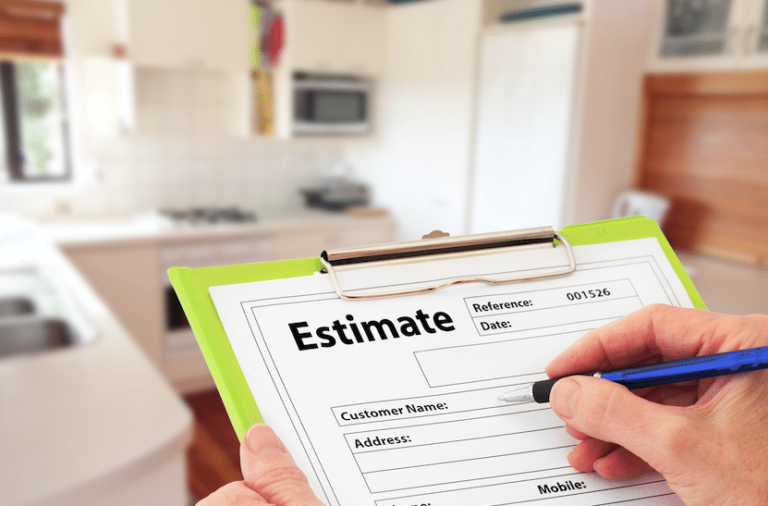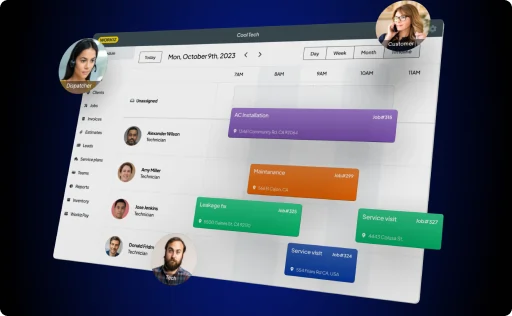But many contractors don’t know how to let potential clients know that they are the best for the job.
Thankfully, writing an estimate is not as hard as you think. Prices need to be clear, and the prospect’s concerns should be addressed upfront.
If you’re having trouble writing a killer estimate, we’ll show you exactly what to include and make it a no-brainer to book you for the job.
Writing your estimate: Consultation process
A polished and thorough contractor estimate has all the nitty-gritty details. Ask a variety of open-ended and closed-ended questions to get to know your prospects, like: “what is your final vision for this remodel? or “what date do you want the project completed by?”
Set realistic goals and expectations. Give the prospect a peek into your work process and show them how well you handle disagreements on the fly.
Send over a follow-up email to review the meeting and have the prospect confirm the details again.

What should you include in your contractor estimate?
Estimates vary by industry, but you should always include these core sections:
- Contact information:
Include an email, phone number, website, location, and office hours of both the contractor and prospect. - Project Summary:
Write an overview of the project and your team’s process for completing and delivering the final vision. - Payment:
Your payment policies should include payment date and schedule, payment methods (cash, credit, or installments), and cancellation or late fees. If you want to manage your cash flow, ask for an upfront payment of raw materials. Your options include 100% upfront, 20-50% deposit, or milestone payments. - Itemized cost outline:
Here’s where you list every element needed to complete the project and its expected cost. The more descriptive and detailed, the better.- Raw materials:
Breakdown the quantity, length, finish, color, model, price, and year. A kitchen stove includes several parts (burner, control panel, door) so list individual parts that make up a whole. - Taxes on materials:
Add any store tax or shipping taxes. - Equipment costs:
The cost of the supplies, tools, machinery, and gas. - Labor costs:
The hourly wage or fixed price for your team. - Subcontractors:
Outsourced labor or services to complete the project. - Discounts or sales:
Add in special offers or discounts.
- Raw materials:
- Quote Total:
Add up the expected cost of the project. - Signature:
The prospect and contractor should sign the estimate and agree to the price. To make it easier, use a system that lets your customers e-sign invoices and other documents.
Should you charge for contractor estimates?
Contractors have notoriously been pigeonholed into giving away estimates for free. Would you put more effort into writing your estimate if you charged for it? Let’s look at both sides.
Writing for free:
- PROS: Easier to attract leads
- CONS: You could lose hours of your time if prospects don’t sign-on
Charging a price:
- PROS: Recoup money spent writing an estimate (which can take days)
- CONS: You may turn away qualified leads
Solution:
A lot of work goes into project specifications, and your business deserves to be paid for the effort. If you’re not ready to charge, send out estimates to prequalified prospects and give a ballpark number to ones who seem to be window shopping.

Avoid this costly mistake
Remember, prospects are playing the field. They’re in contact with 3-4 contracting companies, sizing everyone up and waiting for any excuse to eliminate you.
Do you know how many leads you are losing each week? It’ll blow your mind once you sharpen your sales process. Prospects owe you nothing, so it’s up to the contractor to follow up days, weeks, or even months later to close a sale.
Workiz allows you to create multiple estimates for a job in seconds and track the estimates to see which one wins. If you have several pricing packages for projects, this feature will allow you to see which one is the best, providing valuable insight into your lead generation process.
Many contractors simply are not reaching out enough to prospects, waiting too long, or not delivering the support the prospect needs to make a decision. Workiz will remind you to send a follow-up email so you can shorten the time it takes to close sales (and book more jobs.)
Final thoughts
You and your prospects both want the same thing: an awesome final project you can’t wait to show off.
But unless you have a step-by-step process to show off your value and talent, prospects will choose to spend their money elsewhere.
Good contractors make mistakes when providing estimates, while great contractors excel at fixing them and keeping their prospects interested.
Sign up for a free, 7-day trial of Workiz so you can easily send out estimates, track their progress and close more paying jobs.









